
Understanding Guitar Grounding
Practicing your guitar makes you a better guitar player. Understanding guitar wiring makes you a better Tone Wizard. And, properly grounding your guitar’s electronics makes your guitar as quiet as it can be. In today’s article, we will delve into the world of grounding: The basics, common myths, and best practices!
THE BASICS
A Ground (or Earth) connection is a term that relates to a multitude of topics related to electrical engineering. For our intents and purposes, a proper Ground connection is an essential part of your guitar’s wiring. A Ground Connection connects every piece of metal on your guitar and acts as a return path to the amp. In part, the Guitar’s Ground Connection helps remove unwanted noise, and is essential for safety – It allows electricity to travel safely to the amp to dissipate.

Your guitar is surrounded by many things that emit or produce EMI, or electromagnetic interference. Look around you – you’re probably in front of a computer, near some lighting, and most likely close to some electrical lines.
These are all sources of EMI, and there are thousands of them all around us. Your guitar will pick up a multitude of these. However, if you properly ground your guitar, you can get your guitar as quiet as it can be (single coils will still hum), and not introduce sound via improper grounding.
GUITAR GROUNDING MYTHS
There are a few Guitar Grounding Myths that we want to dispel:
MORE IS BETTER:
Definitely not. Proper grounding means it only needs to connect correctly to the ground once. Grounding items multiple times creates a few problems. For one, using wire to ground a series of pots in a circle creates a one-turn coil. If you’ve checked out our article on humbuckers, then you know that EMI usually enters the coil, not through the magnetic field. Creating a loop of ground connections will introduce noise into your signal.
Take a look at the following images. You’ll see an incorrect and proper way to ground a Gibson Les Paul®.
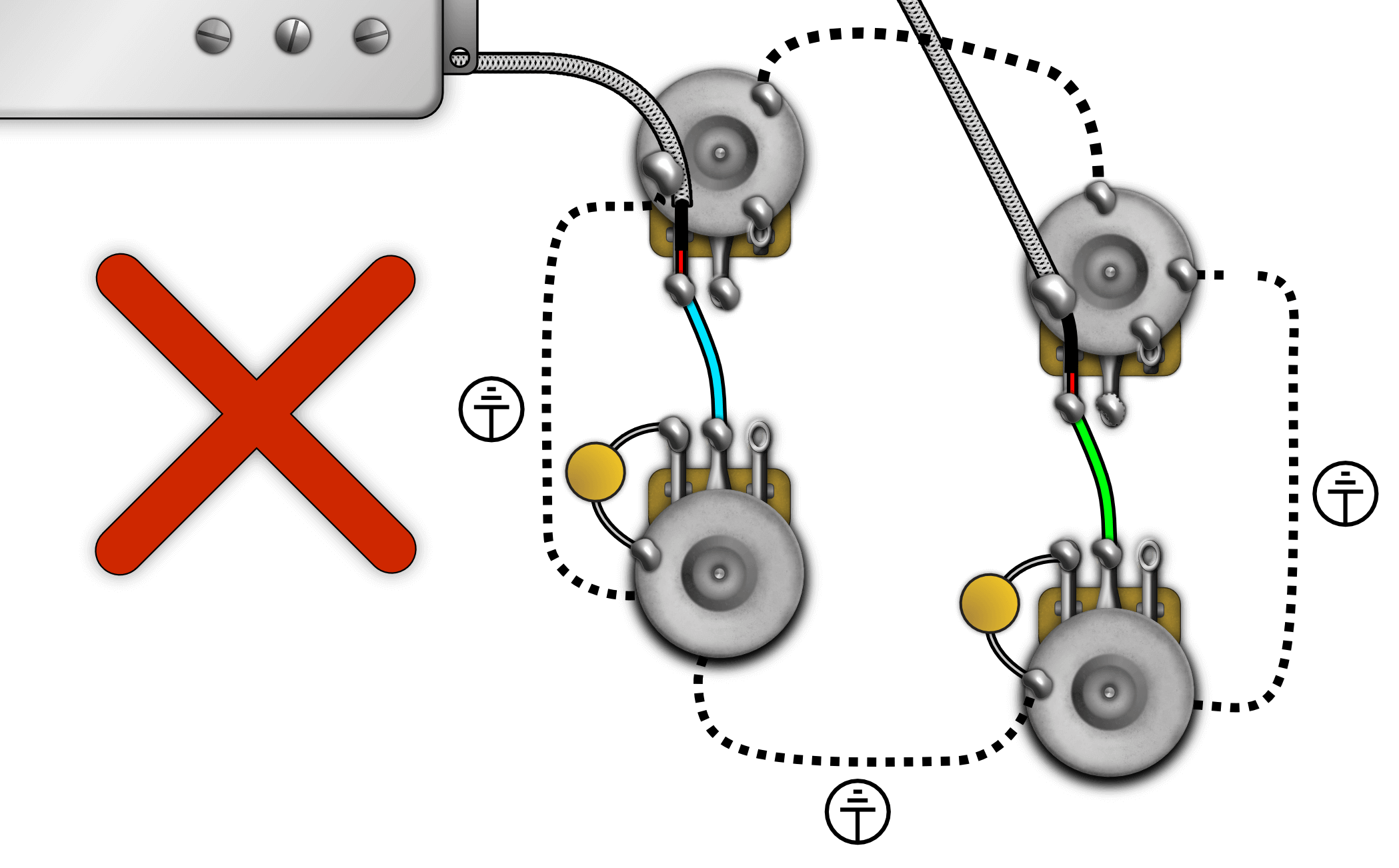
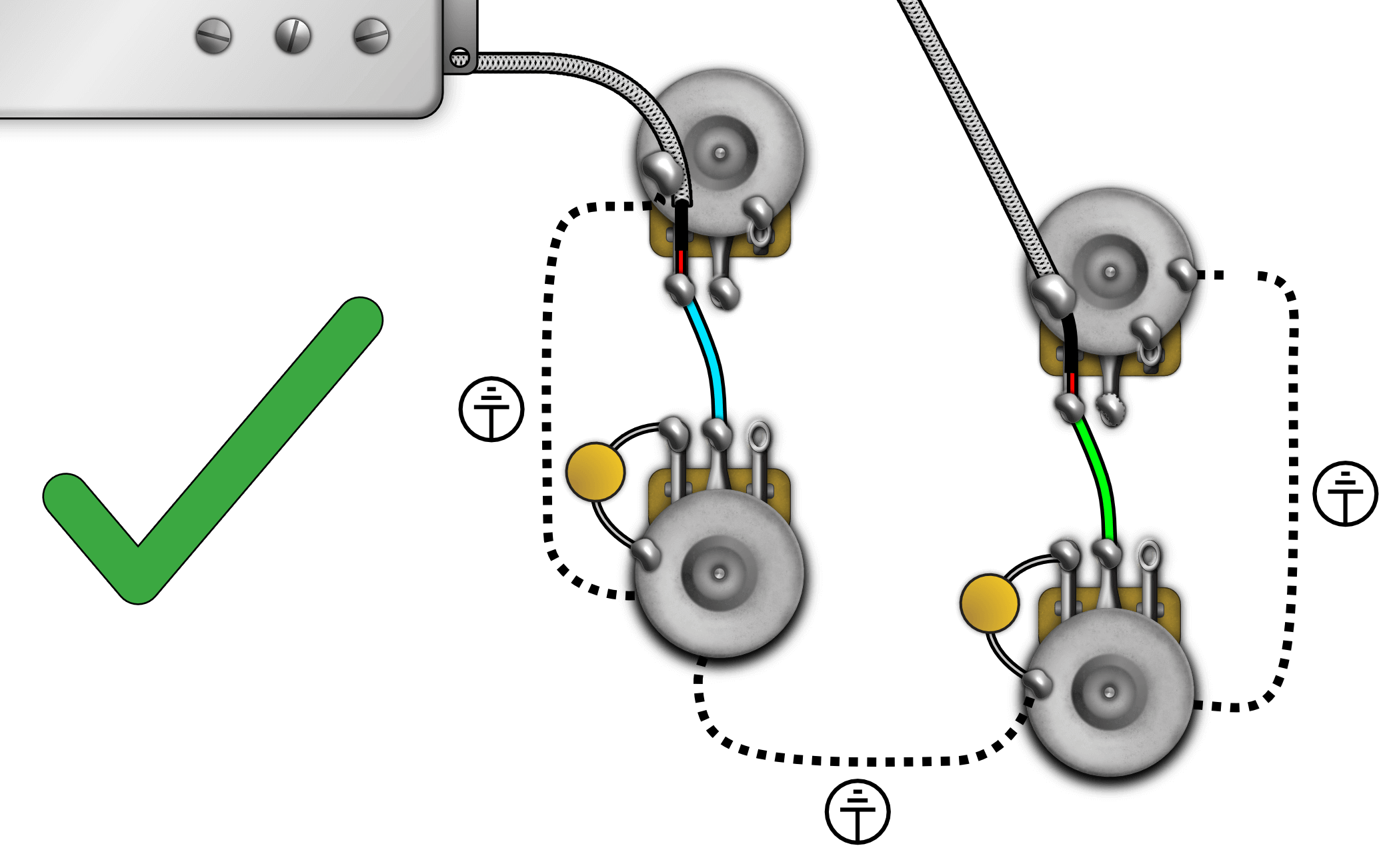
YOU GROUND OUT THE STRINGS
Grounding your strings is essential for having a quieter guitar. If you’ve ever noticed your guitar’s noise gets quieter when you touch the strings, you might have thought your body grounds your guitar’s parts. You’d be wrong if you did. It turns out, a human being makes a pretty good EMI (Electromagnetic Interference) antennae! Your body is an antenna for all sorts of EMI, so when you touch your guitar strings, the guitar is grounding you! Pretty cool, right?
“STAR” GROUNDING: GOOD OR BAD?
Star Grounding refers to the method of grounding that connects all grounds to a Single Point. For example, think of the back of a Strat Volume Pot: It tends to be a central hub for ground connections. Some electrical engineers state that Star Grounding doesn’t make a difference, but Lindy prefers this method. His reasoning? All ground connections connect to the output jack sleeve anyway. Also, it’s harder to create a ground loop by practicing Star Grounding.
BEST PRACTICES
CONNECT EVERYTHING, BUT CONNECT IT ONCE.
Take a look at the following image of a Strat – notice how each part connects to ground once. Notice any jumpers? The Shielding on the back of the pickguard is connecting everything. If you were to add jumpers between pots, you’d be creating a “Ground Loop,” and introducing noise into your circuit.
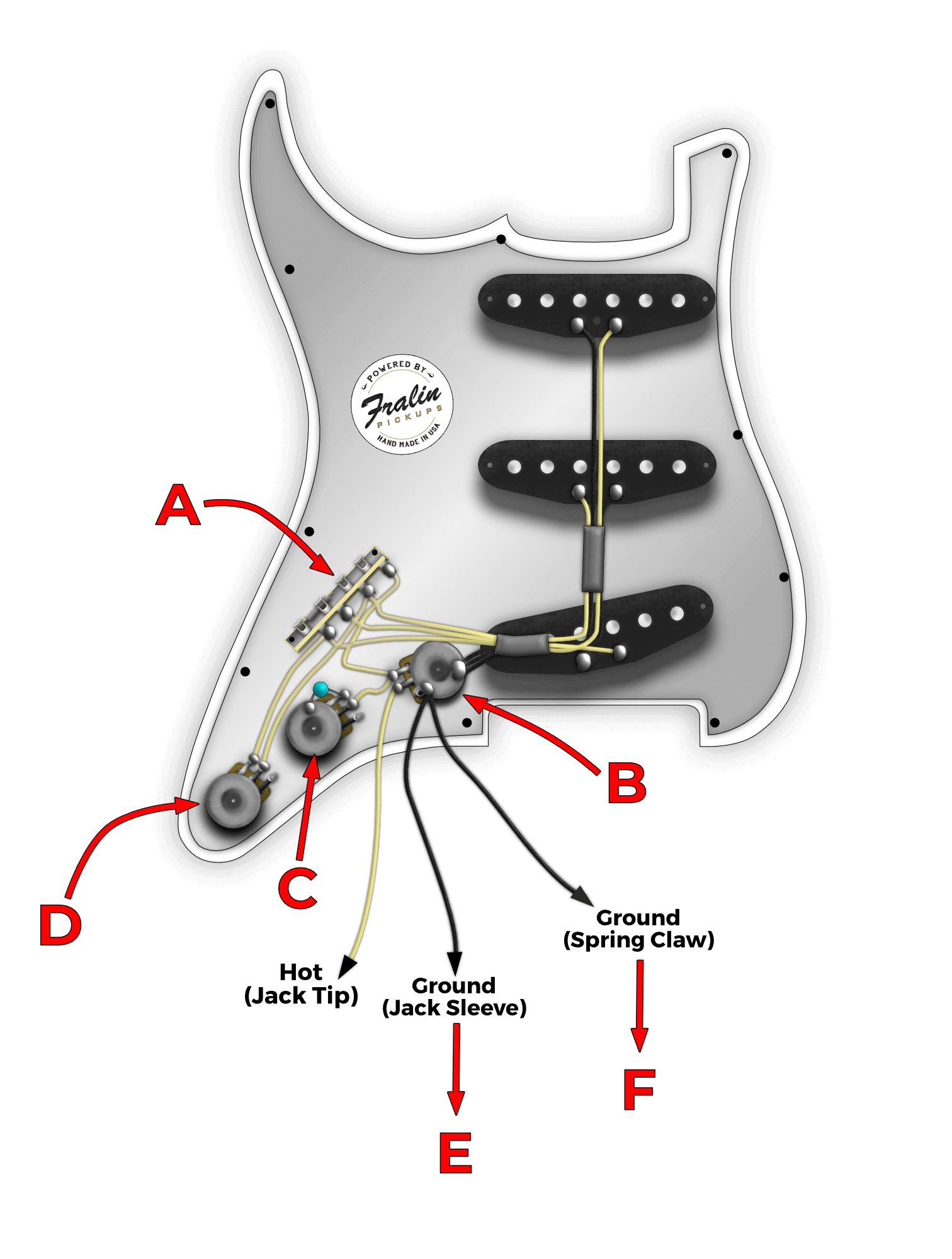
This is a method of “Star Grounding”. You can see that the Volume Pot is more or less a central hub for all points of ground contact. Adding more ground jumpers to the parts will create more ground paths, and introduce noise. However, there’s one main output – the Output Jack’s sleeve. If your pickguard does not have shielding: you’ll need to add shielding or jumpers to ground your guitar’s electronics.
PAY ATTENTION TO YOUR SURROUNDINGS
A lot of grounding mistakes come from not checking your surroundings. If your parts mount to a metal plate or shielding, chances are, they are already connected electronically. In this situation, running extra jumper wires would only over-ground your electronics.
The Telecaster Control Plate pictured below is connecting all electronics. By connecting only one ground wire from the Volume Pot to the Output Jack, you ground your parts thoroughly.
See below:
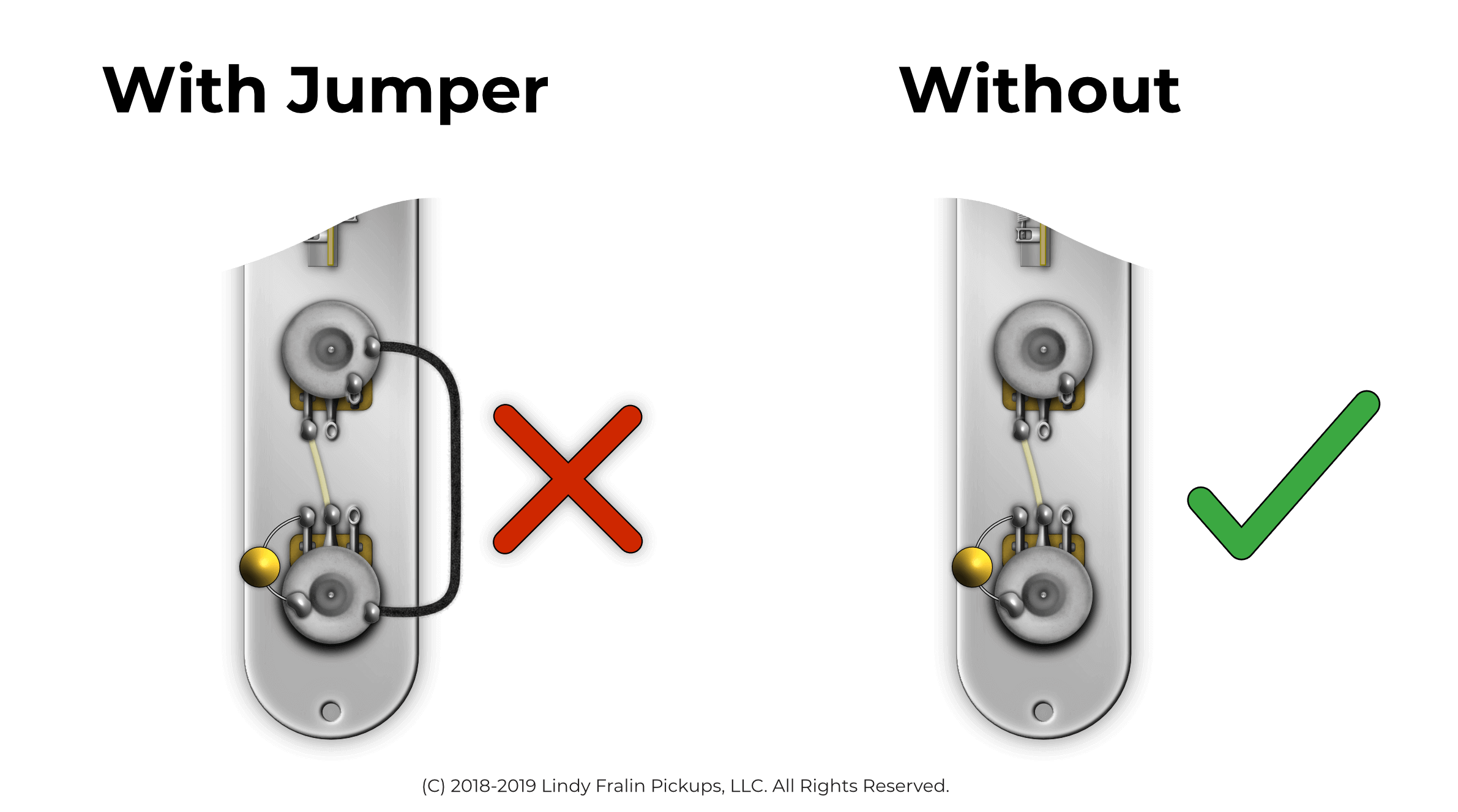
If your bridge pickup’s screws thread into the steel plate like ours do, then that should be enough to ground out your strings, since the steel plate connects to ground. Furthermore, double-check to make sure there are no stray ground wires wedged under the Saddle Plate.
HUNTING DOWN GROUND PROBLEMS
If you’re experiencing Ground problems on your guitar, there’s an effortless way to hunt them down. If you don’t own one already, invest in a Multimeter – you can purchase a decent one for $25. Follow the following steps here:
- With your guitar’s electronic cavities open, turn your multimeter to the D.C. Resistance setting, about 20K.
- Hold one terminal on the back of the volume pot, (B on the above strat pickguard image)
- Use the free terminal to touch every metal piece, and pay attention to the reading of the Multimeter.
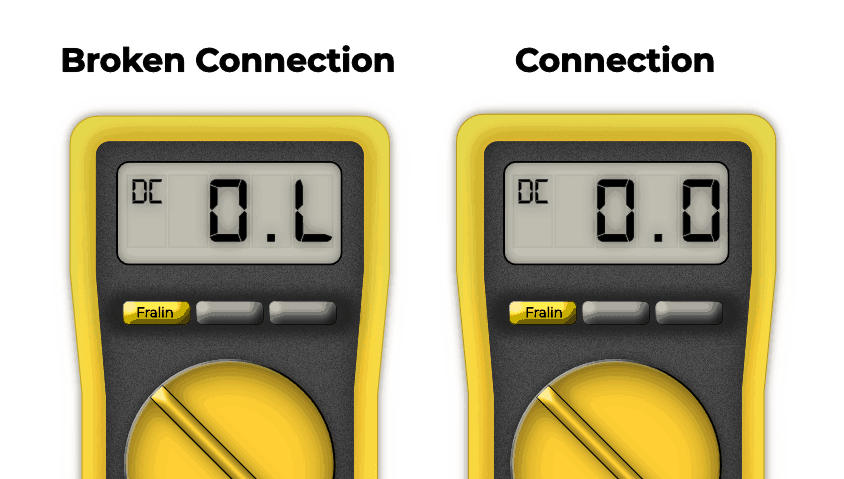
If your Multimeter reads “0.0”, you have a solid connection – there is zero resistance between the two parts. If your Multimeter reads “0.L”, you have a severed connection, and this is at least one of your problems. You’ll need to run a ground jumper to make sure the part gets appropriately grounded.
Note: Make sure you perform this on every part of the guitar, including the Bridge, Switch, and Output Jack Sleeve Tab.
Note 2: If everything checks out in your guitar, start looking at your cable. Check to make sure that your cable’s sleeve is correctly attached to ground.
Lastly, Note 3: If you have Shielding or Conductive Paint, make sure that there is a connection to ground.
That should just about do it for now! Grounding is very simple: make sure everything is grounded, but only once. Don’t overthink it!
Comments
81 Comments For This Post
Leave A Comment
Want to chime in to the conversation? Please do so! Please respect others.


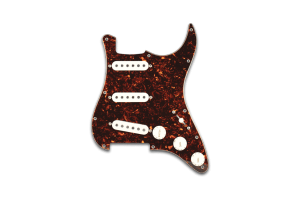
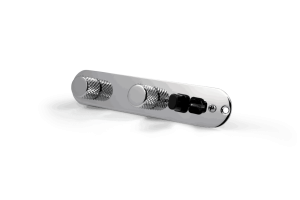
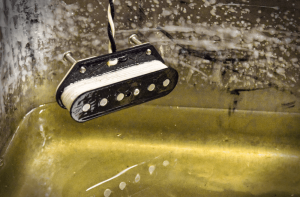
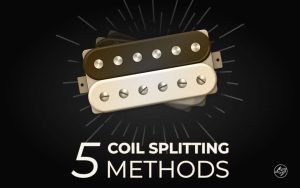

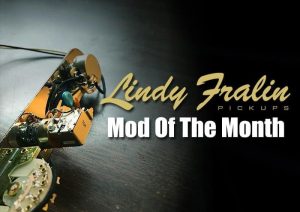

The biggest problem with hum and noise in the guitar world is that crappy unbalanced jack plug and unbalanced wiring.
In the microphone world we have been working with balanced signals for decades. These microphone signals are much lower than from a guitar pickup and the input of a microphone amplifier is much more sensitive than that of a guitar input. Despite this, absolutely no hum can be heard in the professional microphone world.
It’s time for the guitar manufacturers to get professional and balance their pickups and eventually replace that old-fashioned crappy jack plug with a decent XLR (like in the microphone world).
I just installed a set of Fralin Vintage Hot (strat) pickups. Only the bridge pickup has a metal plate at the bottom. The pickups are suspended VIA a metal ring, which once the guitar is painted, will be grounded. Also the pickup sockets be wrapped in copper. is it safe to assume a single ground wire from rings to socket wraps back to the output lug ground is enough to properly ground the coils ? (understanding the coil ground is grounded to the volume pot)
Hey Billy, yes, based on your explanation, I believe you have it figured out.
Great info, especially thank you for the multi-meter guidance!! Will be calling you soon to make a purchase!
Thank you for writing this, it’s very helpful. Is there a troubleshooting guide like this for active pickups? I’ve built a guitar with a set of EMGs, which uses solderless connections, and I’m getting no sound, not even a hum. The solder points are at the battery box, the barrel jack, and the three way switch, so that’s likely where the problem is, but I don’t know how to test or what to look for. The cavities are painted with shielding paint, so maybe a connection is touching where I can’t see. How would I check that? Should I test it with the battery in or out?
Hey Drew, really the best way is to reverse trace the signal from the output jack with a multimeter. Set your multimeter to the Ohms setting and select 20K as the multiplier. Connect a short guitar cable and keep reading the “tip” of the cable. This will be your “hot”. Select a pickup and turn the volume up all the way. With the additional free terminal on the multimeter, start working backward starting with the sleeve of the guitar cable, the output jack chassis, etc. If you’re getting an “0.L”, that means the circuit is broken somewhere – the guitar signal cannot reach the output jack. If you’re getting a “0.0”, that means there’s a short, or there’s 0 resistance from ground to hot – either something is wired wrong, or a critical signal path is getting pinched to ground. Good luck!
When I use the meter it doesn’t say either 0.0 or 0.L, it says 0.01 I have it set to 20K Is a reading like 0.01 like 0.L?
Hey Brian, what are you measuring? If it’s “point A to point B” grounding-wise, 0.01 is more like 0.0. There might be the slightest resistance, and you can check by making sure your solder joints connecting the two parts are good and solid.
I was wondering if a metalic guitar armrest needs to be grounded.
And i think the answer is yes…
Can anyone confirm?
If I understand correctly, the amp has a 3 prong grounded plug. Wouldn’t soldering a ground wire to the housing of the amp output jack on the guitar and then to the electronics be the way to go?
Hey Bob, your amp chassis is already grounded through the plug. I wouldn’t solder anything in your amp – they can be quite dangerous to work with.
@Greg, I’m having trouble envisioning the “circle of metal” thing you propose. Can you clarify? If the light bulb has one connection to ground or 100, of course it will still be on. But if we were, for some strange reason, to significantly amplify the signal coming from the bulb, we would notice a lot more environmental noise from the one with 100 grounds. Not because the electrons are confused, but because a ground loop behaves like, and can be modeled as a secondary winding of an isolation transformer, whose primary winding is everything around you that carries current. Through the magic (I mean, physics) of induction, a current is induced in that ground loop. This is how radio works, and the secondary winding is called an antenna. It’s a tiny amount of current, to be sure, but your pickups only generate tiny voltages, and your amp has very high input impedance because it knows it can’t draw much current when it reads those voltages.
As for the pickguard, no it is not “line like,” nor does it need to be. If it only has one connection to ground, it will catch electromagnetic interference, and dump it off to ground, acting as a shield. But if it is connected to ground in multiple spots, again, it becomes an antenna, and a big one. Extra jumpers do, indeed, create extra *conductive* surface to ground, but that’s not all they do. They also create additional *inductive* secondary windings to your transformer.
All wire in fact has a resistance there are no perfect conductors outside the realm of superconductors which requires (nowadays) near absolute zero temperatures. Additionally wire has an inductance as well even a straight piece of wire will induce magnetic eddies. The wire only seems to have no resistance with commonly used ohmmeters. In the real world we don’t normally use meters capable of registering these resistances. If we use a Wheatstone bridge circuit we can measure extremely low resistances. Most of the time we don’t need to worry about the resistance of the wires but it still exists. These tiny resistances are what create the ground loops.
I’m surprised by the number of claims of ground loops in this article. What are described in the diagrams are certainly physically “loops”, but the electrons don’t know that. They will find the path to ground along the shortest route, not get tricked into going in circles never to escape! At worst, adding jumpers when not needed or closing the 4 pots with a redundant jumper is just a wasted length of wire. It will not introduce noise.
Imagine if you will, a simple test circuit of a light bulb and a battery, connected with 2 lenths of wire. Now open the sleeve on one of those wires and stick a circle of metal to it. Will the light bulb still be on? Of course it will. Look at the example of the Les Paul style wiring… in the “correct” one, it is analagous to the single wire. With the extra redundant jumper, it’s analagous to adding that weird extra circle of metal to your circuit. But no loop has been formed despite looking physically like a loop. The pathway is continuous and it will all still lead to ground.
I mean, you yourselves mention the shielding on a pickguard or tele plate. These are also not visually “line-like” pathways, and yet they don’t cause loops. Adding the extra jumpers simply increases the “surface” of the ground path.
Years ago Guitar Player magazine published a book called “Fixing You Axe” in it they recommended soldering a 1/4 watt/ 220 ohm resistor between the final ground wire and the output jack of the guitar. This they said was a safety feature. They said it would still adequately ground the guitar but the resistor would act as a voltage limiter keeping and shock you might receive to a low amount. Your thought?
Most good electrical engineers would advocate star grounding to a single point. IMO If it doesn’t make a difference likely grounding isn’t the problem.
This is a great article. I never knew multiple grounds could produce noise. When I re-wire my Telecaster, I will definitely rely on the component plate to ground pots. A number of years back I shielded all the cavities, then grounded each in piggy-back fashion to the control cavity, then to the rear of one of the pots. I never heard a single-coil guitar sound less quite. I suggest this for any player looking to reduce extraneous noise. However, with no experience and only a very basic understanding of grounds, I worry about what happens when the properly grounded components come in contact with the cavities shielding tape – will this cause multi-grounding, noise spikes, etc? Right now, when I touch the pots I get noise spikes. Do you think this is because the pots are coming into contact with the shielding tape?
After I initially left a comment I appear to have clicked
on the -Notify me when new comments are added- checkbox and from now on each time a comment
is added I recieve four emails with the same comment.
Is there a means you are able to remove me from that service?
Cheers!
I shield my friend’s guitars with this tape, https://polymertape.com/products/copper-tape, it’s actually good, easy and effective.
I have a question but it doesn’t appear answers are forthcoming at this point.
Anyway, I’m trying to put a preconfigured Strat pickguard in a Squire I picked up. It wasn’t function properly so I started checking things only to find out the resistance from ground to the bridge, which is wired, changes with the volume control. I have no schematic but they sent a wiring diagram. It appears to be correct but I’ll have to give it a closer look. Anyway, I hopefully will have it fixed but it’s more for info, and in the even anyone else happens to run into the same problem.
Hi there, really interesting read, thanks. Would a guitar and a wired IEM be able to share the ground in the same lead? For example if I made a dual purpose lead with one ground but three cores …1 core for the guitar and two cores for the headphones and then share the ground. Would that be asking for trouble? Many thanks.
Hi,
I have a persistent problem with my Les Paul: a solid hum (particularly at vol 8 and tone 8) until I touch the strings or a metal part (bridge, tailpiece…)
The grounding is OK by measuring with a meter, it has the “horseshoe” grounding shape as by your diagram, there is a groundwire anchored to one of the bridgestuds, so everything looks good. But everytime I stop touching a metal part, it hums. My other guitars plugged into the same rig are dead quiet (included an i35 with exactly the same wiring). So what’s going wrong?? Thank you for your help !
I have a relatively complex tele control plate: stacked volume and tone for each humbucker, and a master volume control that is also a push pull coil split. And an irritating buzz/hum. I found Tyler’s article on grounding and then removed FIVE unnecessary ground wires. Now the guitar is quiet and I am very happy. Thank you.
All my guitars (humbuckers and single-coils, both factory setup and replaced-pickups) have a hum problem with all my amps until I touch the strings… all amps are grounded properly. What could the cause be? I’ve turned off all fluorescent lights and it’s still apparent.